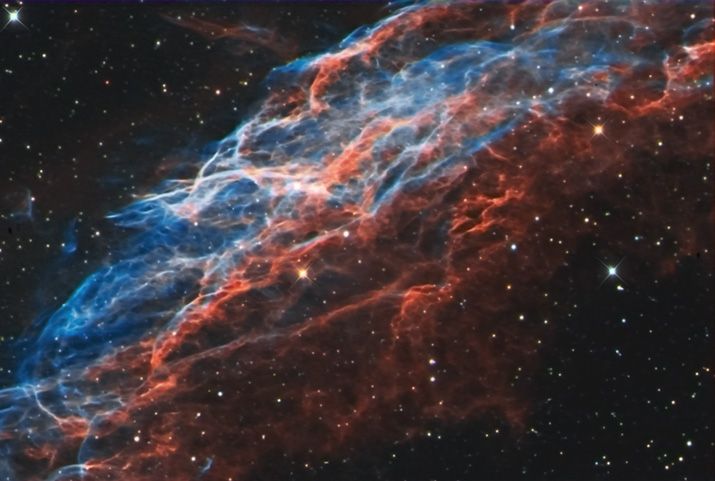
|
Date: Aug, 7 & 8, 2015 Location: Denton, TX Telescope: ATRC12 Camera: ST-10XME Mount: MI-250 Exposure: Ha = 4.5 hours - OIII = 6 hours. - (30 min sub-exposures binned 1X1) Guided using Innovations Foresight On Axis Guider (ONAG) Click on the image below to view at higher resolution. |

|
NGC 6992 is the bright northern part of the Eastern Veil Nebula. It is located in the constellation Cygnus - The Swan. The distance to the Veil is somewhat uncertain. Recent studies estimate the nebula lies a maximum distance from the Earth of 1,470 light-years. This is much closer than previous estimates of approximately 2,500 light-years. The entire Veil Nebula, known as the Cygnus Loop, is very large and spans an area approximately the width of 6 full Moons. It is thought that the star that gave birth to the Veil exploded between 5000 and 8,000 years ago. Astronomers estimate the supernova explosion had a peak brightness magnitude of -8. This would be about as bright as a crescent moon. It would have been a spectacular sight! Supernova explosions seed interstellar space with heavy elements that new stars, and their planets, incorporate when they are born. Life, as we know it, could not have developed without the heavy elements created in the cores of stars like the one that formed the Veil Nebula. The image above was captured using Ha (Hydrogen Alpha) and OIII (Doubly Ionized Oxygen) narrowband filters. The image was assembled by mapping Ha to red and OIII to blue. A synthetic green channel, consisting of a combination of Ha and OIII data, was used. A Tri-Color Hubble Palette mapped narrowband image of NGC 6992 may be viewed here. 1 https://en.wikipedia.org/wiki/Veil_Nebula
|